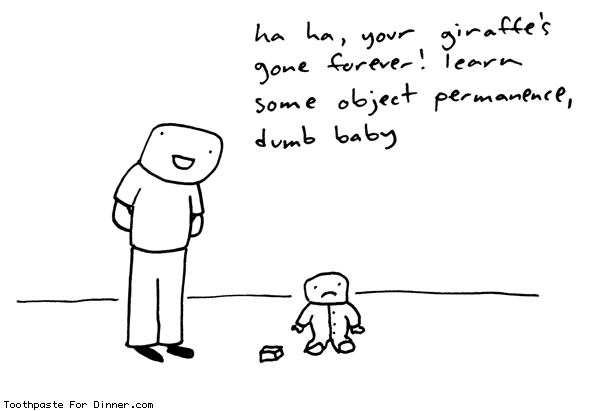
[Comic: Toothpaste For Dinner]
At first glance, human babies don’t seem that bright. They eat, they sleep, they cry. But they also learn at an astounding rate. While they are still in the womb, they learn proprioception, where their limbs are in relation to themselves, and how to move them. When they are born, they need to quickly learn how to breathe (just-in-time learning, if you will). They also get access to an entirely new sense - vision. Babies learn face recognition, structure from motion, and depth from stereo faster and better than the state of the art computer vision algorithms. Similar things can be said for a baby learning how to move about and manipulate its environment (robotics), learning how to understand and communicate with others (computational linguistics), and learning how to enjoy music (beat detection). Even more incredible, is that all this learning is going on while the baby’s brain grows from a single cell when the baby is in the womb, to the complex network of neurons in a developed brain. It’s like learning how to fly a plane as it is being assembled from parts all around you.
Artificial intelligence is a field with a lot of cool stuff happening. We have computer programs that can beat human grandmasters at chess, spam email filters that operate at over 99% accuracy, and programs that can compose piano music indistinguishable from the greats. But, how much of this can we actually call artificial intelligence, and how much is hand-wavy fakery? Can Deep Blue learn how to play Go? Can a spam filter learn to love? Why is it that a baby can learn to solve any problem and adapt to any environment, while we haven’t even come close to creating a robot with such versatility and adaptability?
The problem may be that artificial intelligence has been too focused on advanced behaviors like game playing (chess), classification (spam filter), and rule breaking (computational creativity) and less so on fundamentals like motivation, environment modeling, and agent self-introspection. After all, you must learn how to crawl before you can run.
tl;dr – Babies are awesome. We need to learn how they learn.


1 comment:
I know significantly less than you about this. But! I think true AI (I greatly dislike using the term artificial in this case, but for the point being) is only going to come about with biotechnology, and at that point its another beast entirely.
There is new research (I don't have internet links, but I do have books, if you're interested) that our higher intelligence, be it spirit, soul, being, etc, resides in our astrocytes, which are a type of neuroglia in our brains. Neuroglia is connective tissue designed to fill space and make nerve impulses travel at a quickened rate. Thus research is showing that the cell that makes us "be" is connective tissue, a structure that is more difficult to copy as machinery because it doesn't function as a nerve. Astrocytes send and receive each neurotransmitter our bodies can produce, yet they don't conduct signals as neurons do. They behave in a sentient manner and can respond to stimuli without a neruon's threshold of response being reached at all.
Babies specifically have an explosion of glial growth at birth and again at age 5 when the brain nears its final stages of development. In the early years of five and below, astrocytes will actually kill neurons to make room for more glial space as a baby's awareness of being grows. Pair this with a neuron's capacity to store information and the limbic system's ability to interpret it, and the learning is unmatched.
I guess my end point is for something to come into being it has to take existance to consciousness. Until recently we didn't know our body's intelligence resides in tissue designed to bring one place closer to another. How do you take something we so barely understand and breathe it into something else as life?
-Mariah
Post a Comment